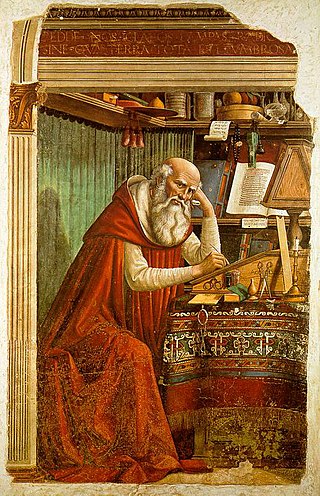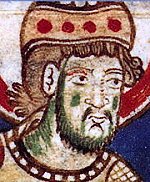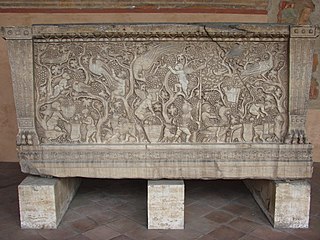
The First Council of Constantinople was a council of Christian bishops convened in Constantinople in AD 381 by the Roman Emperor Theodosius I. This second ecumenical council, an effort to attain consensus in the church through an assembly representing all of Christendom, except for the Western Church, confirmed the Nicene Creed, expanding the doctrine thereof to produce the Niceno-Constantinopolitan Creed, and dealt with sundry other matters. It met from May to July 381 in the Church of Hagia Irene and was affirmed as ecumenical in 451 at the Council of Chalcedon.

The Liber Pontificalis is a book of biographies of popes from Saint Peter until the 15th century. The original publication of the Liber Pontificalis stopped with Pope Adrian II (867–872) or Pope Stephen V (885–891), but it was later supplemented in a different style until Pope Eugene IV (1431–1447) and then Pope Pius II (1458–1464). Although quoted virtually uncritically from the 8th to 18th centuries, the Liber Pontificalis has undergone intense modern scholarly scrutiny. The work of the French priest Louis Duchesne, and of others has highlighted some of the underlying redactional motivations of different sections, though such interests are so disparate and varied as to render improbable one popularizer's claim that it is an "unofficial instrument of pontifical propaganda."

Pope Damasus I, known as Damasus of Rome, was the bishop of Rome from October 366 to his death. He presided over the Council of Rome of 382 that determined the canon or official list of sacred scripture. He spoke out against major heresies, thus solidifying the faith of the Catholic Church, and encouraged production of the Vulgate Bible with his support for Jerome. He helped reconcile the relations between the Church of Rome and the Church of Antioch, and encouraged the veneration of martyrs.
Pope Marcellus I was the bishop of Rome from May or June 308 to his death. He succeeded Marcellinus after a considerable interval. Under Maxentius, he was banished from Rome in 309, on account of the tumult caused by the severity of the penances he had imposed on Christians who had lapsed under the recent persecution. He died the same year, being succeeded by Eusebius. His relics are under the altar of San Marcello al Corso in Rome. Since 1969 his feast day, traditionally kept on 16 January, is left to local calendars and is no longer inscribed in the General Roman Calendar.

Pope Siricius was the bishop of Rome from December 384 to his death. In response to inquiries from Bishop Himerius of Tarragona, Siricius issued the Directa decretal, containing decrees of baptism, church discipline and other matters. His are the oldest completely preserved papal decretals. He is sometimes said to have been the first bishop of Rome to call himself pope.

Year 1048 (MXLVIII) was a leap year starting on Friday of the Julian calendar.
Pope Damasus II was the head of the Catholic Church and ruler of the Papal States from 17 July 1048 to his death on 9 August that same year. He was the second of the German pontiffs nominated by Emperor Henry III. A native of Bavaria, he was the third German to become pope and had one of the shortest papal reigns.
Christopher claimed the papacy from October 903 to January 904. Although he was listed as a legitimate pope in most modern lists of popes until the first half of the 20th century, the apparently uncanonical method by which he obtained the papacy led to his being removed from the quasi-official roster of popes, the Annuario Pontificio. As such, he is now considered an antipope by the Catholic Church.

The Portuguese Catholic Church, or Catholic Church in Portugal, is part of the worldwide Catholic Church in communion with the Pope in Rome, under the Portuguese Episcopal Conference. The Catholic Church is the world's largest Christian organisation. It is Portugal's largest religion and its former state religion, and has existed in the territory since the Iberian Peninsula was ruled by the Roman Empire.
Ursicinus, also known as Ursinus, was elected pope in a violently contested election in 366 as a rival to Pope Damasus I. He ruled in Rome for several months in 366–367, was afterwards declared antipope, and died after 381.
The Gelasian Decree is a Latin text traditionally thought to be a Decretal of the prolific Pope Gelasius I, bishop of Rome from 492–496. The work reached its final form in a five-chapter text written by an anonymous scholar between 519 and 553, the second chapter of which is a list of books of Scripture presented as having been made part of the biblical canon by a Council of Rome under Pope Damasus I, the bishop of Rome from 366–383. This list is known as the Damasine List. The fifth chapter of the work includes a list of distrusted and rejected works not encouraged for church use.
The Council of Rome was a synod which took place in Rome in AD 382, under the leadership of Pope Damasus I, the then-Bishop of Rome. The only surviving conciliar pronouncement may be the Decretum Gelasianum that contains a canon of Scripture, which was issued by the Council of Rome under Pope Damasus in 382, and which is identical with the list given at the Council of Trent.

Tarsicius or Tarcisius was a martyr of the early Christian church who lived in the 3rd century. The little that is known about him comes from a metrical inscription by Pope Damasus I, who was pope in the second half of the 4th century.

The Minor Basilica of St. Lawrence in Damaso or simply San Lorenzo in Damaso is a parish and titular church in central Rome, Italy that is dedicated to St. Lawrence, deacon and martyr. It is incorporated into the Palazzo della Cancelleria, which enjoys the extraterritoriality of the Holy See.

Furius Dionysius Filocalus was a Roman scribe and stone engraver, specialized in epigraphic texts, who was active in the second half of the fourth century.

Saints Marcellinus and Peter are venerated within the Catholic Church as martyrs who were beheaded. Hagiographies place them in 4th century Rome. They are generally represented as men in middle age, with tonsures and palms of martyrdom; sometimes they hold a crown each.
The historical roots of Papal primacy can be traced back to the early centuries of Christianity, wherein the Bishop of Rome, commonly referred to as the Pope, gradually accrued increasing authority and recognition. A confluence of historical, theological, and political factors contributed to this development.

The Catacomb(s) of Callixtus is one of the Catacombs of Rome on the Appian Way, most notable for containing the Crypt of the Popes, which once contained the tombs of several popes from the 2nd to 4th centuries.
Damase is a personal name, the French-language counterpart of Damasus.
Heraclius was a Roman who, in 310, opposed the election of Pope Eusebius, earning him the title of antipope. All that is known of Heraclius appears in an epitaph written by Pope Damasus I for Eusebius. Heraclius and Eusebius disagreed over the policy which should be taken towards the lapsi. Damasus' epitaph is ambiguous as to whether Heraclius' position was that the lapsi should be readmitted to the church without compelling them to do penance, or that they should not be readmitted at all.










